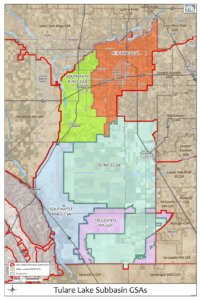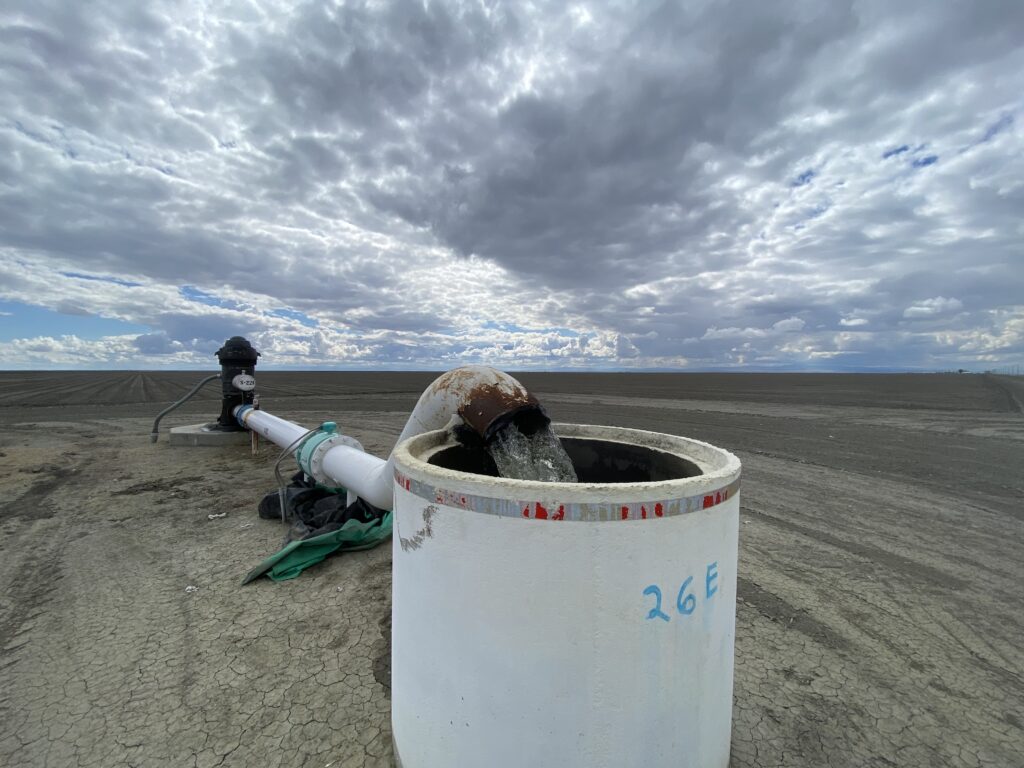“Urgent” concerns about rapidly sinking land and potential harm to residential wells pushed the groundwater subbasin covering Kings County to the front of the line among several San Joaquin Valley water regions slated to go before the State Water Resources Control Board.
Still, the hearing for the Tulare Lake subbasin won’t come until April 16, 2024, the Water Board announced during a briefing held Wednesday, Oct. 11. That’s too slow for some advocacy groups who’ve said excessive groundwater pumping has continued unabated, even during drought, drying up residential wells.
The Water Board is the state’s enforcement arm under its Sustainable Groundwater Management Act.
Another state agency, the Department of Water Resources has been tasked with guiding groundwater agencies over the last five or more years to come up with plans to bring critically over pumped aquifers back into balance by 2040.
The Tulare Lake subbasin failed in those efforts – twice.
So did five other valley subbasins including the Delta-Mendota, Chowchilla, Kaweah, Tule and Kern subbasins.
All six of those valley regions submitted plans with a variety of problems, according to the state, including poor minimum water levels, lack of protection for domestic wells, unaddressed subsidence, or land sinking, and an overall lack of coordination among groundwater agencies within the subbasins.
The Tulare Lake subbasin’s plan did not properly show how it would halt declining groundwater levels or address subsidence and water quality degradation, according to state staff.
It was picked as the first subbasin to come before the board because state staff found there are urgent impacts to domestic wells and infrastructure, said Natalie Stork, SGMA program manager at the Water Board.
SJV Water first reported how unlikely Tulare Lake’s plan was to pass state scrutiny back in 2020. The plan didn’t list any specific projects aimed at reducing pumping or increasing aquifer recharge. And it allowed for the City of Corcoran, which had already sunk the equivalent of a single-story house over the previous decade and a half, to sink up to another 11 feet.

Tulare Lake is also the home turf of an ongoing water war between John Vidovich, owner of Sandridge Partners LLC and the J.G. Boswell Farming Company. Both have pumped enormous amounts of groundwater over the years and have battled each other in the process.
Vidovich has long claimed Boswell has been selling off its surface water, then pumping excessive amounts of groundwater and storing it in shallow basins to irrigate its massive farming operation in the old Tulare Lake bed.
That fight found its way into the Tulare Lake groundwater plan. One of the groundwater agencies controlled by Vidovich inserted language stating: “To the extent allowable by law the GSAs will work with local and state regulatory agencies to prevent the inefficient storage of groundwater in shallow basins.”
The other groundwater agencies in the subbasin did not include that language, making the plans incompatible, which isn’t allowed under SGMA.
The Water Board’s probationary hearing is just one of multiple steps on the pathway to state intervention. If subbasin agencies do not adequately amend a plan, the Water Board can intervene and impose its own pumping plan and fees, instead of local agencies controlling the plan.
Subbasins put on probation will have at least one year to make fixes before the state imposes its own plan.
If the state decides to put a subbasin on probation, it will charge a $300-per-well registration fee for water users and a fee of $40 per acre foot pumped alongside any GSA fees. Those fees only apply to water users that use more than two acre feet per year, generally excluding domestic well users. The fees are meant to recoup state costs of the intervention process and are not penalties, said Stork at the briefing.
Tulare Lake subbasin’s hearing was originally slated for December of 2023 but state staff pushed the date back to April of 2024 for “a robust public comment period and good stakeholder engagement,” said Stork during the briefing.
“We recognize that the timing for some is not soon enough,” said Stork at the briefing. “And for some it might be too soon.”
So far, no dates have been set for the other inadequate subbasins.
Advocacy groups throughout the valley have been critical of the slow speed of SGMA and the bureaucracy behind the timelines.
The goal of sustainability by 2040 and the initial timelines of the law may have made sense back when the law was passed, said Michael Claiborne, directing attorney for nonprofit Leadership Counsel for Justice and Accountability. But given the extreme years of drought since, it doesn’t make sense anymore, he said.
“Waiting for sustainability until 2040 means that households lose access to drinking water, that wells go dry. And trying to react to that in the interim is just not very effective,” said Claiborne.
By fall of 2022, the last year of the most recent drought, more than 1,000 drinking water wells in the valley went dry, according to DWR’s dry well reporting system. Those numbers only reflect what was reported to the state meaning the true number of dry wells is likely much higher.
“I think state intervention should be faster,” said Claiborne. “Unfortunately, with the way the law was designed, there are all these off ramps before you get to real impactful state intervention.”
Still, advocates are glad the state has not simply rubber stamped all the plans, said Claiborne.
“This is the first time that we’ve done this here in California,” said Stork at the briefing. “There’s a lot of considerations to be made. And so we recognize the urgency of the situation and we are working through this as urgently as we can but with thought and consideration, and also just bandwidth.”
Share this:
- Click to share on Facebook (Opens in new window)
- Click to share on Twitter (Opens in new window)
- Click to share on LinkedIn (Opens in new window)
- Click to share on Reddit (Opens in new window)
- Click to share on Tumblr (Opens in new window)
- Click to share on Pinterest (Opens in new window)
- Click to share on Pocket (Opens in new window)
- Click to share on Telegram (Opens in new window)
- Click to share on WhatsApp (Opens in new window)
- Click to print (Opens in new window)









You must be logged in to post a comment.